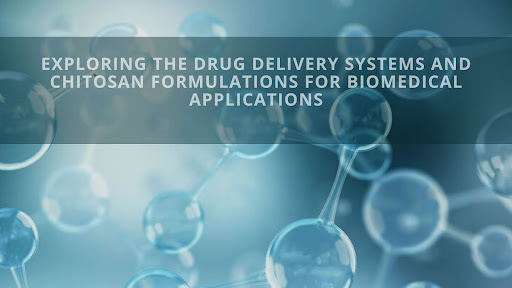Chitosan is a naturally occurring biopolymer with an array of advantageous properties, including biodegradability, biocompatibility, and low immunogenicity, making it a favorable material for various applications in the biomedical field.
The process of deacetylation involves the removal of acetyl groups from chitin, which results in a polymer with a high degree of amino groups, giving chitosan its unique cationic character.
Chitosan’s unique physicochemical properties have made it an attractive material for drug delivery applications. Its cationic charge allows it to interact with negatively charged surfaces and molecules, making it an excellent carrier for drugs, genes, and proteins.
Furthermore, chitosan can be chemically modified to alter its properties, such as its molecular weight, charge density, and hydrophobicity, to improve its performance in specific applications.
With increasing interest in harnessing chitosan’s potential, a wide range of chitosan formulations has been developed for targeted drug delivery, gene therapy, tissue engineering, and wound healing applications.
Medical Chitosan Formulations: Enhancing Efficacy and Safety in Drug Delivery
Drug delivery systems (DDSs) have been developed as a means of improving the efficacy and safety of drug therapy. However, many traditional drug delivery systems are associated with adverse effects and poor bioavailability, which significantly limits their utility.
Recently, chitosan-based formulations have emerged as a promising alternative for drug delivery with significant advantages in terms of biocompatibility, biodegradability, and non-toxicity.
Chitosan is characterized by its unique properties, such as mucoadhesion, controlled release, and the ability to encapsulate various types of drugs. These features have made chitosan-based formulations highly attractive for targeted drug delivery, enhancing drug efficacy while minimizing adverse effects.
Its formulations have been shown to improve the bioavailability of drugs and reduce their toxicity by enhancing their solubility and stability. Chitosan’s mucoadhesive properties have also been used to develop DDSs for the treatment of mucosal diseases, such as oral ulcers, inflammatory bowel disease, and colitis.
Furthermore, chitosan nanoparticles have been utilized to deliver drugs to the brain, where conventional DDSs fail to reach. A chitosan company usually provides many formulation options and the ability to customize according to your research project.
One of the most significant advantages of chitosan-based formulations is their ability to target specific cells, tissues, or organs.
Targeted drug delivery is an essential aspect of drug therapy, as it allows for the effective concentration of drugs at the site of action, resulting in improved efficacy and reduced toxicity. For example, chitosan nanoparticles have been used to target cancer cells by incorporating specific ligands on their surface, which selectively bind to cancer cells and deliver anticancer drugs to the site of the tumor.
As the demand for safer and more effective drug delivery systems continues to grow, chitosan-based formulations have the potential to transform the future of drug therapy.
Chitosan Formulations
Some of the most popular chitosan formulations include chitosan nanoparticles, hydrogels, microspheres, films, and sponges, which have been shown to possess desirable features such as high drug loading capacity, controlled release, and enhanced cellular uptake. By leveraging these characteristics, chitosan-based formulations have the potential to revolutionize the biomedical industry with novel therapies and medical devices.
| FORMULATION | DESCRIPTION | APPLICATIONS |
| Chitosan nanoparticles | Nanoparticles made of chitosan, typically with a size range of 10-100 nm. |
|
| Chitosan hydrogels | Three-dimensional hydrophilic networks made of chitosan. |
|
| Chitosan scaffolds | Porous three-dimensional structures made of chitosan. |
|
| Chitosan coatings | Thin films or coatings made of chitosan. |
|
| Chitosan microspheres | Microspheres made of chitosan, typically with a size range of 1-1000 μm. |
|
| Chitosan-based composites | Composite materials made of chitosan and other materials, such as ceramics, polymers, or metals. |
|
In recent years, there has been a growing interest in the development of various chitosan formulations for targeted drug delivery, wound healing, and tissue engineering applications.
Chitosan Nanoparticles
Chitosan nanoparticles are one of the most widely used chitosan formulations due to their small size and high surface area-volume ratio. They have attracted attention for their drug delivery applications, as they can encapsulate and deliver drugs to the targeted site. The surface of nanoparticles can be modified with targeting agents that allow the delivery of drugs to specific cells or tissues. Chitosan nanoparticles are also used for gene therapy and vaccine delivery. Targeting agents can be attached to the surface of the nanoparticles, allowing for specific delivery to cells or tissues. These nanoparticles have shown excellent biocompatibility and low toxicity, making them an ideal choice for biomedical applications.
Chitosan Hydrogels
Chitosan hydrogels are three-dimensional networks of chitosan chains that can absorb a large amount of water. They are used for tissue engineering, wound healing, and drug delivery applications. Chitosan hydrogels can be prepared using various methods such as chemical crosslinking, physical crosslinking, and enzymatic crosslinking. They can be used as scaffolds to support cell growth and differentiation, and their porosity allows for nutrient and oxygen diffusion to the cells. They have shown excellent biocompatibility and biodegradability, making them ideal for tissue engineering and wound healing applications. Additionally, chitosan hydrogels can be used to deliver growth factors, cytokines, and other signaling molecules that promote cell growth and differentiation.
Chitosan Microspheres
Chitosan microspheres are spherical particles of chitosan that are used for targeted drug delivery applications. They can be prepared by emulsion or spray-drying methods. Chitosan microspheres can be used to encapsulate and release various drugs, including proteins and peptides, which are otherwise difficult to deliver orally due to enzymatic degradation in the gut. Chitosan microspheres show excellent drug loading and sustained drug release properties, making them the best choice for long-term drug delivery applications.
Chitosan Films
Chitosan films are thin films of chitosan that are used for wound healing, tissue engineering, and drug delivery applications. Chitosan films can be prepared by various methods, such as solvent casting, spin coating, and electrospinning. They have shown excellent biocompatibility and biodegradability, making them best for biomedical applications.
Chitosan Sponges
Chitosan sponges are porous structures of chitosan that are used for tissue engineering and wound healing applications. They can be prepared using various methods such as freeze-drying, solvent casting, and gas foaming. Chitosan sponges are three-dimensional structures that can be used in tissue engineering applications. The sponges can be incorporated into scaffolds to support cell growth and differentiation, and their high porosity allows for efficient nutrient and oxygen diffusion to the cells. Chitosan sponges can also be used to deliver drugs and growth factors to the target site, promoting tissue regeneration and repair.
Conclusion
To date, different chitosan formulations have been developed and studied for their potential use in drug delivery, tissue engineering, and wound healing applications.
Notably, chitosan nanoparticles, hydrogels, microspheres, films, and sponges have received much attention due to their excellent biocompatibility and biodegradability properties, which make them attractive options for diverse biomedical applications in research, provided you choose the best chitosan supplier.
It is necessary to be able to get the best products from your chitosan producer to ensure reliable results.
In conclusion, the diverse and beneficial properties of chitosan and its various formulations have opened up exciting opportunities for the development of novel therapeutic strategies and biomedical devices in different fields.






